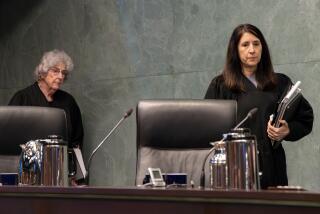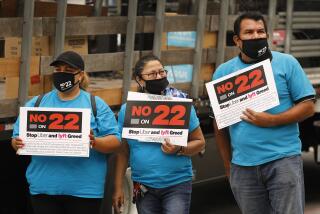Column: With Janus ruling, Supreme Court seals a 40-year campaign to eviscerate worker rights

In what was probably its least unexpected ruling, written by the least unexpected justice, the Supreme Court on Wednesday delivered a blow to public workers for which the right wing has been thirsting for decades.
The court’s decision in the case of Janus vs. AFSCME seemed a foregone conclusion, following a few near-misses in recent years. The court’s conservative majority had made no secret of its hostility to public employee unions in a string of earlier cases. The author of the Janus decision, Justice Samuel A. Alito Jr., had become the leading spear carrier in this campaign after the 2016 death of its previous leader, Antonin Scalia.
The Janus ruling applied to one key aspect of public employee contracts — the so-called agency fee. That’s the fee that public employee unions in 22 states, including California, charge workers who are represented by those unions but don’t wish to be associated with the unions’ political or ideological positions.
Judicial disruption does not get any greater than what the court does today.
— Justice Elena Kagan, dissenting
The idea is that those workers’ free-speech rights are infringed if they have to pay for political activities, so they pay the smaller agency fee to cover only contract-related union functions such as contract negotiations and enforcement, including grievance procedures. Writing for a 5-4 majority, Alito decided that their free-speech rights are infringed anyway.
Alito’s decision elicited outrage from Democrats and progressives. “Special interests have been rigging the system against the working class for far too long,” stated Rep. Ro Khanna (D-Fremont). The Supreme Court, he said, “just came down on the wrong side of history.”
The same viewpoint came from inside the court. “Judicial disruption does not get any greater than what the court does today,” Justice Elena Kagan wrote in a ringing dissent. “There is no sugarcoating today’s opinion,” which interferes in public debate about workplace governance “by weaponizing the First Amendment.”
But it’s proper to note that the Supreme Court’s engagement with worker rights has a very long history, and more often than not it has been on the wrong side. One might look back at the 1920s and 1930s, when the court consistently held against workers in cases involving wage and workplace issues.
In Adkins vs. Children’s Hospital (1923), the court overturned a minimum wage act for women on the grounds that it ostensibly violated the constitutional liberty of contract, as though a corporation and an individual employee came to the bargaining table with equal power.
With Adkins as a precedent, the court overturned a New York minimum wage law in 1936. The ruling elicited widespread indignation. In his diary, Franklin Roosevelt’s Interior secretary, the liberal Republican Harold Ickes, castigated the court for upholding “the sacred right … of an immature child or a helpless woman to drive a bargain with a great corporation.” He added, “If this decision does not outrage the moral sense of the country, then nothing will.”
He was right. The court’s obdurate conservatives were then facing popular condemnation for their hostility to the New Deal, and when a minimum wage case next came before the court, it reversed itself, upholding a Washington state law. It was 1937, FDR had just won a resounding reelection victory, and the court saw fit to scurry over to the right side of history.
The next landmark came 40 years later, in Abood vs. Detroit Board of Education. This is the 1977 precedent that Alito struck down Wednesday. It had established the principle that, in return for a public union’s legal obligation to represent members and nonmembers equally in negotiations with public employers, its work-related duties should be compensated.
The agency fee aimed to eliminate the free-rider problem. As Kagan observed in her dissent, “everyone — not just those who oppose the union, but also those who back it — has an economic incentive to withhold dues.” The agency fee ensures that a union will receive enough funds to perform as a negotiating partner to public employers. “As more and more stop paying dues,” however, “those left must take up the financial slack (and anyway, begin to feel like suckers) — so they too quit the union.”
Ever since Abood, conservatives have had the knives out for the agency fee. A leading battleground has been California. Conservatives hoping to silence union members tried three times at the ballot box — in 1998, 2005, and 2012 — to outlaw agency fees. They failed every time.
Then they turned to the courts. In 2015 came Bain vs. California Teachers Assn., which was finally dismissed by a federal appeals court on June 11 because none of the plaintiffs was still employed as a teacher.
Another case, Friedrichs vs. California Teachers Assn., had been filed in 2013, but made it to the Supreme Court in 2016 because the plaintiffs fast-tracked it, hoping to exploit the conservative majority on the court. But after oral arguments were heard, Scalia died, leaving a 4-4 split on the case that left intact a prior appeals court ruling rejecting the plaintiffs’ arguments.
Once the conservative majority was restored by the appointment of Justice Neil M. Gorsuch, the anti-union crowd brought forth Janus, which emerged from Illinois.
As Kagan noted in her dissent, the 1st Amendment aspects of all these cases is mere window dressing. The plaintiffs’ real goal, as it was in the California ballot initiatives, is to silence public employees, who can constitute a potent bloc for progressive ideals.
The evidence for that comes from the roster of backers of all these cases: The anti-Abood coalition has included right-wing groups such as the American Legislative Exchange Council, or ALEC, and the State Policy Network. They’re affiliated with the Koch brothers, the Sarah Scaife Foundation, the Mercer Family Foundation and the Walton Family Foundation.
In previous rulings, Alito has made no secret of his contempt for Abood. He devoted most of his decision Wednesday to attacking what has been the governing precedent on public unions for 41 years. He quotes himself as having termed Abood “something of an anomaly” in 2012 and “questionable on several grounds” in 2014, and says in the current ruling that “Abood went wrong at the start.”
He argues that governing conditions have dramatically changed since 1977, citing an increase in the cost of government since the 1970s. (“Not all that increase can be attributed to public-sector unions, of course,” he acknowledges charitably.)
But his distaste for public workers and their unions drips from every word. He cites “the considerable windfall that unions have received under Abood for the past 41 years,” as though public employers have received scarcely any value from employees for their wages and benefits — it’s all just a “windfall.” And he grouses about unions’ tendency to aim their political rhetoric at Wall Street and “corporate tax loopholes” and income tax cuts, all sacred cows of the 1%, who will be distinct beneficiaries of this ruling.
Alito sets up his opinion as a dialogue between himself and Kagan, who has consistently defended Abood against his assaults. She’s up to the challenge, though she didn’t have the votes.
Nothing in the changed employer-employee landscape, she argues, warrants overturning Abood, which has successfully guided state and local employment relations since 1977. This wasn’t about the 1st Amendment, Kagan observes. Rather, the majority “wanted to pick the winning side in what should be — and until now, has been — an energetic policy debate” over the role of unions in the public sector. “Today, that healthy — that democratic — debate ends…. Maybe most alarming, the majority has chosen the winners by turning the First Amendment into a sword.
“The First Amendment,” she concludes, “was meant for better things.”
Keep up to date with Michael Hiltzik. Follow @hiltzikm on Twitter, see his Facebook page, or email [email protected].
Return to Michael Hiltzik’s blog.
More to Read
Get the L.A. Times Politics newsletter
Deeply reported insights into legislation, politics and policy from Sacramento, Washington and beyond. In your inbox three times per week.
You may occasionally receive promotional content from the Los Angeles Times.











